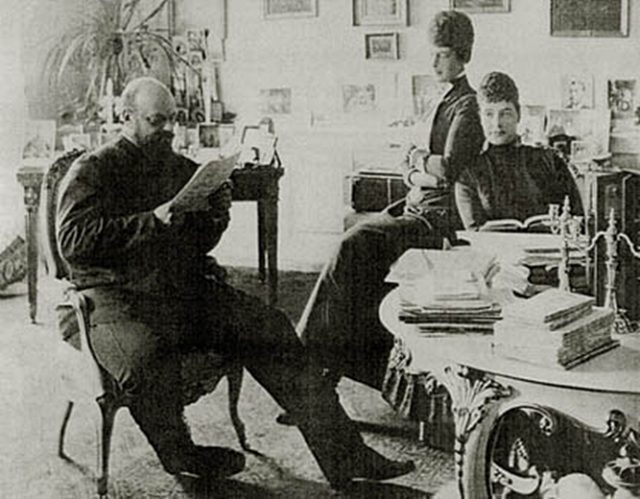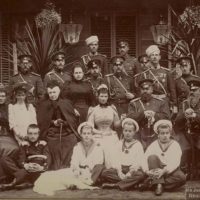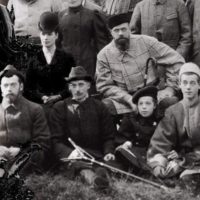
Related

Alexander III with members of Romanov family

Alexander III with members of Romanov family

Alexander III with members of Romanov family

Alexander III with members of Romanov family

Alexander III with members of Romanov family

Alexander III with members of Romanov family

Alexander III with members of Romanov family

Tsar Alexander III and some family members

Alexander III, his family - Public domain portrait photograph
Alexander III with members of Romanov family
Summary
On March 13, 1881, Alexander’s father, Emperor Alexander II, was assassinated in St. Petersburg by Narodnaya Volya, and Alexander unexpectedly succeeded to the throne. On the day of his assassination, Alexander II had signed a proclamation creating a consulting group to advise the Emperor, which some considered a step towards constitutional monarchy. The new emperor, Alexander III, canceled the new policy before it was published. Alexander thought that the empire would have been permeated by anarchist troublemakers and revolutionary agitators. He created the Okhrana, the secret police and he launched a policy of Russification. No major wars were fought during Alexander’s reign and he was nicknamed “The Peacemaker.” One of the most important accomplishments during his was the planning and the beginning of the construction of the Trans-Siberian Railway, the longest railway in the world.
Princess Marie Sophie Frederikke Dagmar was born at the Yellow Palace in Copenhagen. Her father was Prince Christian of Schleswig-Holstein-Sonderburg-Glücksburg, a member of a relatively impoverished princely cadet line. Her mother was Princess Louise of Hesse-Kassel. She was baptised as a Lutheran and named after her kinswoman Marie Sophie of Hesse-Kassel, Queen Dowager of Denmark as well as the medieval Danish queen, Dagmar of Bohemia. Growing up, she was known by the name Dagmar. Most of her life, she was known as Maria Feodorovna, the name which she took when she converted to Orthodoxy immediately before her 1866 marriage to the future Emperor Alexander III. She was known within her family as "Minnie". Due to the brilliant marital alliances of her father, he became known as the "Father-in-law of Europe." Her elder, and favorite, sister, Alexandra married Albert Edward, the Prince of Wales (the future King Edward VII) in March 1863. Alexandra, along with being queen consort of King Edward VII, was also mother of George V of the United Kingdom, which helps to explain the striking resemblance between their sons Nicholas II and George V. Her younger sister was Thyra, Duchess of Cumberland.
Alexander III was the second son of Alexander II and of Maria Aleksandrovna (Marie of Hesse-Darmstadt). During the first 20 years of his life, Alexander had no prospect of succeeding to the throne. His training and acquaintance was with French, English, and German, and military drill. When he became heir apparent on the death of his elder brother Nikolay in 1865, he began to study the principles of law and administration under the jurist and conservative philosopher K.P. Pobedonostsev. The tsesarevich Nikolay, on his deathbed, had expressed a wish that his fiancée, Princess Dagmar of Denmark, known as Maria Fyodorovna, should marry his successor. The marriage proved a happiest one. On March 13 (March 1, O.S.), 1881, Alexander II was assassinated, and the following day autocratic power passed to his son. Alexander III political ideal was a nation with one language, one religion, and one form of administration, he sought to strengthen and centralize the imperial administration.
- 64 Princess dagmar of dennmark Images
- 79 Принцесса дагмар Images: Romanov Empire
- Emperor Alexander III of Russia with his wife Maria Feodorovna and ...
- u/Flyboy_Will - Pholder
- Car Aleksander III, księżniczka Tyru i cesarzowa Maria Fiodorowna
- Alexander III with members of Romanov family
- Prywatne życie cara Rosji [foto] | HISTORIA.org.pl
- Mariya Feodorovna - Мария Феодоровна
- НЕИЗВЕСТНОЕ ОБ ИЗВЕСТНЫХ. Александр III. Миротворец
- ЖЗЛ: Александр III: человек и государь (часть 1)
